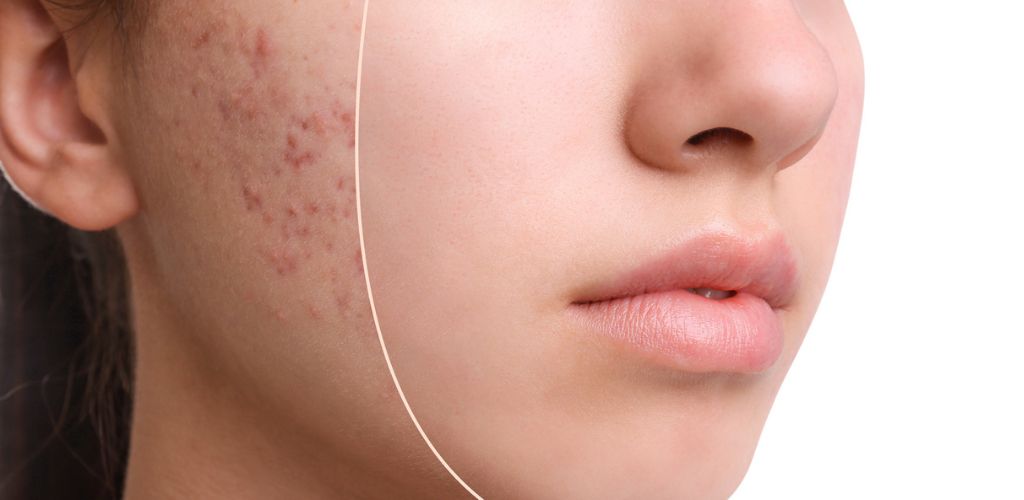What are Face Scars? & How to Hide and Cure Them?

What are Face Scars?
When a wound or injury heals, it leaves a mark on the skin or other tissues. Scars can look different depending on how bad the injury was and where it happened, as well as on your skin type and your genes. Even though scars can’t be completely removed, there are treatments like laser therapy, dermabrasion, and corticosteroid injections that can help make them less noticeable. So if you want to hide and cure face scars then continue to read this article.
Some scars fade but remain as a mark on the face. Whereas every human wants flawless clear skin, especially women, they simply cannot handle wounded or injured faces. Some people even go for surgery to get rid of the marks or any features which make them look even slightly weird.
However, going for the surgery and skin treatment is not easy for everyone as this is a cost-consuming and time taking process. They have different kinds and every other scar has its own remedy and how it needs to get treated. In this article, we will let you know about some treatments and makeup tricks to hide and cure face scars or minimize the scarring on your face.
Kinds of Scars
Scars may vary from skin to skin and they are caused due to different problems and needs to be treated with different approaches.
- Atrophic or depressed acne: They are the most common type the scar. This depressed scar sits below the skin, they formed then the wound is healing it has its 3 types.
- Boxcar: They are wide U-shaped scars having sharp edges, they can be shallow and deep. The shallower they are the better they respond to skin resurfacing treatment.
- Ice pick: Ice pick scars are V-shaped scars that can go deep into the skin. They are difficult to treat as they spread far under the skin.
- Rolling: These are wide depressions that typically have rounded edges and irregular shapes.
- Hypertrophic and raised acne scars: They usually occur in the back and chest. They stand above the surrounding skin and caused due to too much collagen during healing.
- Discoloration left after the zit left the scar, and purple, red, and brown marks will fade over time or a few months to hide and cure face scars.
How to Hide and Cure Face Scars from Makeup?
There are people who don’t want to get into clinical treatment and in natural aspects, it’s not working.
1. Prepare your Skin
First prepare your skin, by applying moisturizing primer and cream, this will you a smooth flawless application. Before getting into the treatment consult your dermatologist and then these products can be used.
2. Cover Discoloration
Discoloration appears unattractive to the face therefore concealers are applied. Using concealer which matches your skin tone covers discoloration of the skin.
3. Foundation
Now apply foundation cream which should be heavy to medium coverage, with a little quantity more on scars.
Tap it slowly and let it stay in the scar area so that it can give coverage to your scars.
In cases of scars, it is a good idea to apply foundation first
Ingredients That Can Help to Hide and Cure Your Face Scars
Scars & marks can be treated with skincare products as well. There are hundreds of products available in the market that not only help to recover your scars but also help to enhance your overall skin texture. Here is the list of ingredients that needs to be in the skincare products you’re using.
1. Alpha Hydroxy Acids
Alpha hydroxy acids (AHAs) work as exfoliants, helping to remove dead skin cells and promoting cell turnover. This can help to reduce the appearance of scars by evening out skin texture and tone. Also, AHAs can stimulate the production of collagen, which is an essential protein that helps to improve skin elasticity and firmness. This can help to reduce the appearance of scars by making the skin more supple and resilient.
2. Lactic Acid
Lactic acid is yet another great product to deal with acne scars and marks. This acid has gentle exfoliating properties that not only help to recover your scars but also make your skin younger and more radiant. Try using less lactic acid at first, and if your skin is very sensitive, only use it twice a week. People with dry skin might feel extra dryness while using lactic acid. To keep your skin healthy, you should use a moisturizer that keeps your skin hydrated.
3. Retinoids
According to a study done in 2017, Retinoids can smooth scars through a process called regeneration. This also improves the skin’s texture and makes scars less noticeable. Also, Retinoids are a type of vitamin it helps to improve the look of skin scars in several ways. Retinoids can help to increase collagen production in the skin, which can help to improve skin elasticity and firmness. This can help scars look less bad because it makes the skin more flexible and strong. As exfoliants, they help get rid of dead skin cells and speed up the turnover of skin cells. This can help scars look less bad by making the texture and tone of the skin more even.
4. Salicylic Acid
Salicylic acid is a beta-hydroxy acid (BHA) that has been shown to offer several benefits for improving the appearance of skin scars. This acid works as an exfoliant, helping to remove dead skin cells and unclog pores. This can help to reduce the appearance of scars by evening out skin texture and tone.
Salicylic acid has anti-inflammatory properties, which can help to reduce redness and swelling associated with scarring. Also, it can help to treat hyperpigmentation by exfoliating the skin and promoting cell turnover. This can help to reduce the appearance of dark spots and make scars less noticeable.
Treatments That Can Help You to Hide and Cure Face Scars:
Dermabrasion
Dermabrasion is a cosmetic procedure that involves removing the top layer of skin to improve the appearance of scars. It is typically performed using a specialized device that abrades the skin with a high-speed rotating brush or diamond fraise. Dermabrasion can be effective in reducing the appearance of scars by smoothing out skin texture and promoting new collagen growth. After the procedure, patients may experience redness, swelling, and some discomfort, but these side effects typically resolve within a few days to a week. It is important to follow proper aftercare instructions, including avoiding sun exposure and keeping the treated area clean and moisturized.
Chemical peels
Chemical peels are a cosmetic procedure that involves the application of a chemical solution to the skin to remove the top layer of damaged skin. This can help to improve the appearance of scars by promoting new collagen growth and smoothing out skin texture. Chemical peels can be effective in treating a wide range of scars, including acne scars, surgical scars, and age-related scars. The procedure can take anywhere from a few minutes to an hour, depending on the severity of the scars. After the procedure, patients may experience redness, peeling, and some discomfort, but these side effects typically resolve within a few days to a week.
Laser resurfacing
Laser resurfacing is a highly effective treatment option for improving the appearance of skin scars. One of the primary benefits of laser resurfacing is its ability to stimulate collagen production in the skin. Also, it can help to improve skin texture and tone. Laser resurfacing can also help to smooth out skin irregularities and reduce the appearance of scars by removing the top layer of damaged skin. Depending on the type of laser used, it can also target specific areas of pigmentation or blood vessels, making it an ideal option for treating hyperpigmentation and vascular scars.



